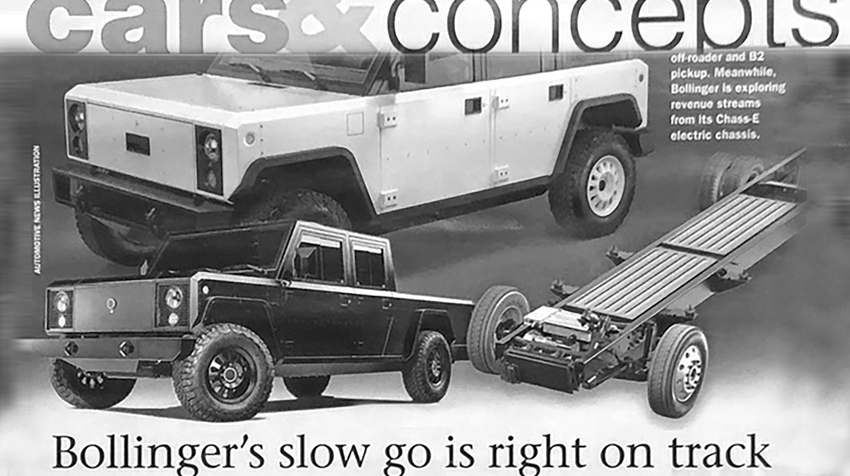RICHARD TRUETT
Reporter covering technology, engineering and Jaguar Land Rover for Automotive News.
DETROIT — Robert Bollinger hears the clock ticking on his EV startup.
The founder and CEO of Bollinger Motors sees the smoking-hot market right
now for electric trucks and utility vehicles, and he knows that if his boxy, retro
looking electric B1 off-road utility and B2 pickup were in production today, he’d
likely sell every one of the $125,000 vehicles he could build.
But he can’t build them — yet. There is still a lot of engineering work to do
before the trucks will be ready for production. There’s the not-so-insignificant
matter of lining up financing to pay the bills, and then there’s a contract
manufacturer to hire.
Now, with two electric pickups — the GMC Hummer EV and Rivian R1T — rolling
off assembly lines and the Ford F-150 Lightning coming in the spring, some of
Bollinger’s first customers have asked for and received refunds of their
deposits.
To a consumer, it probably seems like a hundred years ago since the B1 and B2
debuted at the 2019 Los Angeles Auto Show. But in automotive industry
product development time, Bollinger is moving at normal speed. Recent history
shows it takes a long time for a new company to bring a vehicle to market.
Lucid Motors was founded in 2007. Its first vehicles went home with customers
in October. Rivian started in 2009 and did not sell a vehicle to a customer until
just last month. Bollinger founded his company in 2015.
Life for Bollinger Motors has been a bit tougher. For one thing, the company has
not attracted any billion-dollar benefactors and, up to now, has refused to enter
into one of those trendy SPAC, or special purpose acquisition company, merger
deals, a move that might have filled its bank account but then brought even
more pressure to speed the B1 and B2 to market.
And being a low-volume automaker — perhaps a peak of about 3,000 vehicles
per year — makes dealing with major suppliers extremely difficult. Those
companies are looking to bang out parts in super-high volumes, not make low
volume runs for limited-production vehicles.
Bollinger is still a privately financed company as 2021 closes. However, when I
visited the company in suburban Detroit last week, Robert Bollinger hinted that
that and other things could change in the new year.
“When we were looking into SPACs last summer, we realized it was way too
early for that,” Bollinger told me. “We’ve built the next round of prototypes since
then. And we’ve developed so much more on the commercial side, under the
radar.” Now, he says, “A SPAC and an IPO is never off the table.”
Last week Bollinger took a major step in the pivot from startup to revenue
generating company with the announcement that its commercial Chass-E
electric chassis will be available to one of the nation’s largest upfitters.
Bollinger is working with EAVX, a unit of JB Poindexter, to ensure that the
Chass-E is compatible for a variety of fleet vehicles that one of Poindexter’s
upfitters could use.
A revenue stream from commercial sales has been viewed as a major
advantage for Rivian, which is building 100,000 electric delivery vans for
Amazon. Such a deal could help Bollinger as well.
Last week, during a visit to Bollinger’s engineering center, three engineers were
seen pushing a partially assembled B1 from one bay to another. It’s a more
production-intent version than the engineering mules the company has
developed, Bollinger told me.
While engineers toil away getting the B1 ready for production, Bollinger has
been making progress on other fronts. The company, Bollinger said, has letters
of intent with a number of dealership groups and will have nationwide
distribution when output begins.
Bollinger also said the company expects to end its quiet period in the first
quarter of 2022 with manufacturing and financing news that will show a path to
production.
But that path can and likely will have some unexpected detours. During a recent
drive in a Rivian R1T, a company official pointed to a chrome accent trim piece
on the steering wheel. “That cost us three weeks,” he said, explaining that the
original supplier went out of business. It took Rivian almost a month to find a
new company to make the replacement part, he said, and to ensure that quality
and fit met the company’s specifications and standards.
Bollinger says his electric, four-wheel-drive truck remains the only Class 3, or
medium-duty, EV and that he’s not worried about competitors.
“Even if you have a Ford F-150 electric for your day-to-day driver,” he said, “our
vehicle might still be your crazy-ass toy that you play with on weekends.”
This Automotive News article is available in print and at AutomotiveNews.com

